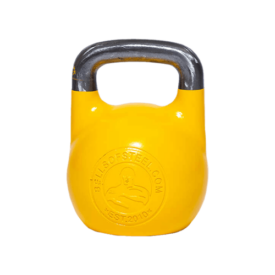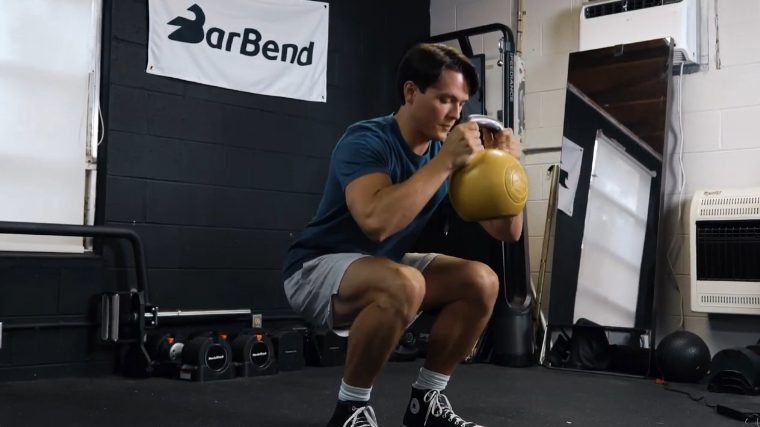If you want to add a lot of workout options to your home gym without taking up a lot of space, a kettlebell is a great way to go. And if you’re going to get a kettlebell, you’ll have a hard time finding one with a better feel and balance than the Bells of Steel Competition Kettlebell. These kettlebells are built to the dimensions required by the Girevoy Sport Union (GSU), the International Kettlebell and Fitness Federation (IKFF), and the International Union of Kettlebell Lifting (IUKL), which means each kettlebell in this line (with two exceptions) has the same handle and bell size for a uniform feel.
Bells of Steel achieves this by creating these kettlebells with a hollow core, which not only provides the means to create bells with the same diameter but different weights, it also means each kettlebell has the same balance and feel regardless of the weight. While competition kettlebells tend to cost more than the standard solid cast iron kettlebells, we think the balance and feel make it worth the cost.

These kettlebells are up to competition-grade standards for GSU and IKFF use as well as meeting IUKL standards. All of the comp weight bells from 10kg to 32kg have international window size so you can train like you play.
Main Takeaways
- The kettlebells are competition-standard, and the handles and diameters are the same through all but two of the weights available.
- There are 16 weights available, from nine to 106 pounds.
- Each different weight is color-coded for easy identification.
Bells of Steel Competition Kettlebell Video Review
Check out our detailed video review as our Reviews Writer, Jake, tells you everything you need to know about these competition kettlebells.
Bells of Steel Competition Kettlebell Highlights
- Price: $49.99 to $469.99
- Weight: Ranges in weight from nine to 106 pounds
- Materials: Alloy steel
- Dimensions: Handle: 2.4 inches high, 4.8 inches wide, 34-35mm diameter; Bell: 11 inches wide, 8.2 inches wide
While it may seem like competition kettlebells are just for people who compete (understandable), anyone who uses a kettlebell regularly can benefit from the feel of using a hollow-core, uniform-sized bell. If you’ve used a Russian-style kettlebell with its solid core and varying bell diameter, you know how it feels to have to adjust to different sizes as you go up and down in weight. With the Bells of Steel Competition Kettlebells, the bell diameter stays the same, so you can perform highly technical lifts like kettlebell snatches and Turkish getups at different weights without any adjustment to how you hold the bell.

When you go to Bells of Steel’s website, you might be a bit shocked at the prices — at $130, Bells of Steel’s 40-pound kettlebell costs nearly twice as much as Rogue’s $70 40-pound bell. But Bells of Steel provides free shipping, where shipping and taxes brings Rogue’s kettlebell up to about $120. If that doesn’t dissuade your concern over prices, the feel of swinging a perfectly balanced hollow-core kettlebell just might. In our experience, the smooth swing is well worth an extra $10 or so.
Another thing to note is the color-coding that Bells of Steel applies to its bells. While most kettlebell companies stamp a kettlebell’s weight onto its body, Bells of Steel goes a step further by making each weight a different color. This not only makes it easier to find the weight you’re looking for, it adds a splash of brightness to any gym.
Pros
- 12 of the 16 weight options conform to GSU, IKFF, and IUKL competition standards.
- The hollow core creates a perfectly balanced feel across the entire weight range.
- Every weight has a different color, so you can instantly recognize the weight you’re looking for.
- The wide grip handle makes it easy to fit both hands inside for swing workouts.
Cons
- The bare steel handles can get slippery when used with chalk.
- The higher price tag of these bells may turn some people off.
- Due to the casting process, the 9-, 13-pound bells have narrower handles and the 79-, 88- 97- and 103-pound kettlebells do not have hollow cores.
Training With the Bells of Steel Competition Kettlebell
To put it plainly, we loved our time with the Bells of Steel Competition Kettlebell. Not only does the hollow core deliver a smooth kettlebell swing and excellent balance, but the bare steel handle felt grippy even after our hands started sweating. Also, the bell’s coating is extremely smooth, which felt great against the skin during front rack movements.
Handle Grip and Comfort
The bare steel handle felt grippy, especially compared to the black powder coat that you get on most standard kettlebells. During swings, the handle felt tacky and secure, and for more dynamic movements like snatches and cleans, it slid smoothly during the grip transition.

At a competition standard 4.8 inches, the window of the handle is wide enough to fit our hands snugly without feeling cramped, but people with larger hands may find it a tight fit.
Weights
The 16 weights available are nine, 13, 18, 20, 26, 31, 35, 40, 44, 53, 62, 71, 80, 88, 97 and 106 pounds. Every weight on this list has the same height and width, and all but the nine- and 13-pound bells have the competition-standard 35mm diameter handle.

The nine and 13-pound kettlebells have 34mm handles to fit smaller hands. Also, all of the weights except for the 80- to 106-pound kettlebells have a hollow core. The heaviest four in the lineup have solid cores.
Surface Finish
These kettlebells are made using solid one-piece casting, which eliminates welding, since the bell is one single piece. This not only improves the durability, but it also eliminates any seams and minimizes imperfections or surface irregularities on the bell. That holds very true for the Competition Kettlebell — it’s extremely smooth. The only markings we found were some chips in the powder coat that occurred during shipping.
Flat Base
The wide, flat base comes standard in competition kettlebells, whereas cast iron and other kettlebells typically have a smaller flat area on the bottom. This makes it much less likely to tip or fall over during floor-based exercises.
What to Consider Before Buying the Bells of Steel Competition Kettlebell
Even though we’re fans of the Bells of Steel Competition Kettlebell, we realize that no single bell suits every person. Before buying a kettlebell, make sure that you find one within your budget, one with the right weight or weight range for your strength level, and whether or not size uniformity is important to you.
Price
These kettlebells aren’t cheap, ranging in price from $49.99 for the nine-pound option to $469.99 for the 106-pound bell. When compared to cast iron kettlebells like the ones from Rogue, that’s a pretty penny, but the quality and feel provide plenty of value for the money.

If that’s not in your budget, you can still find some solid options from companies like Onnit at a lower price. And if you’re looking for multiple weights, an adjustable kettlebell like the REP Fitness Adjustable Kettlebell may be the best option.
Weight Options
Bells of Steel Competition Kettlebells come in 16 different weights, from nine pounds all the way up to 106 pounds, which should be wide enough for everyone from beginners to competitors. And if you end up buying multiple weights, it’ll be easy to tell them apart, thanks to the color-coded coating.
Size and Dimensions
Competition kettlebells have a standard height, grip, and bell diameter across the majority of their weight options (the nine- and 13-pound kettlebells have a 34mm handle). This prevents users from having to adjust how they move to accommodate larger kettlebells as they go up or down in weight. But if a uniform size isn’t an issue, you might be able to save some money by going with a cast iron kettlebell.
Bells of Steel Competition Kettlebell Vs. The Competition
When you’re buying anything, it’s useful to comparison shop, especially before committing to home gym equipment. We decided to compare these kettlebells to one of the most common kettlebells you’ll see in a gym, as well as a powder-coated option and an adjustable option.
| Bells Of Steel Competition Kettlebell | Kettlebell Kings Powder Coat Kettlebell | Rogue Kettlebell | REP Fitness Adjustable Kettlebell | |
| Price (40-pound bell) | $130 | $140 | $70 | $150 |
| Materials | Steel Alloy | Cast Iron | Cast Iron | Cast Iron |
| Dimensions | Uniform | Varies by weight | Varies by weight | One size |
| Shipping Cost | Free | Free | $43 | Free |
| Warranty | Lifetime | Lifetime | Limited Lifetime | Lifetime |
As you can see, the Rogue Kettlebell is the least expensive, even though the shipping cost narrows the gap considerably. The Kettlebell Kings option is the priciest on this list, but it offers a whopping 21 different weight options, so if you’re looking for a 203-pound kettlebell, this is your pick.
Bells of Steel is comparable to the Kettlebell Kings Powder Coat Kettlebell as well as the REP Fitness Adjustable, but despite being the least expensive of the three, it has the perks of having a hollow core build and a standard size across most of the weights.

If you want multiple sizes but space and money are tight, the REP Fitness Adjustable Kettlebell might be a smart choice. It does top out at 40 pounds, so if that’s not heavy enough, that’s probably not going to work for you.
Overall, these are all solid choices. Just do your research and figure out which one is best for your home gym needs.
Places to Buy
You can purchase the Bells of Steel Competition Kettlebell on Amazon or directly through the Bells of Steel website.
Warranties
Bells of Steel offers a lifetime warranty on these kettlebells, covering any manufacturing defects.
Company Information
Bells of Steel offers a wide range of fitness equipment, from free weights to power racks and even cardio equipment. You can contact a team member via email at support@bellsofsteel.us or by phone call at 1-888-718-7997.
In Conclusion
Kettlebells offer great value, thanks to the amount of exercises you can do with them, and the Bells of Steel Competition Kettlebells are some of the best that we’ve tested. The hollow core build creates a perfectly balanced swing, and the uniform bell size allows you to use different weights without having to adjust your form.
These kettlebells come in 16 different weights, so users of varying strength and skill levels will be able to find one that fits their needs. And while they’re on the pricier side, the excellent balance, grippy feel, and lifetime warranty make these an excellent buy.
FAQs
How much do the Bells of Steel Competition Kettlebells cost?
The nine-pound kettlebell is the least expensive at $49.99, and the prices increase as the weights go up, all the to $469.99 for the 106-pounder.
What weights are Bells of Steel Competition Kettlebells available in?
Bells of Steel offers these kettlebells in nine-, 13-, 18-, 20-, 26-, 31-, 35-, 40-, 44-, 53-, 62-, 71-, 80-, 88-, 97-, and 106-pound options.
What workouts can I do with Bells of Steel Competition Kettlebells?
The movement options are nearly endless with a kettlebell. You can perform movements to work your whole body, from goblet squats and Romanian deadlifts for your lower body to kettlebell snatches, kettlebell swings, or kettlebell rows for your upper body, to name a few.